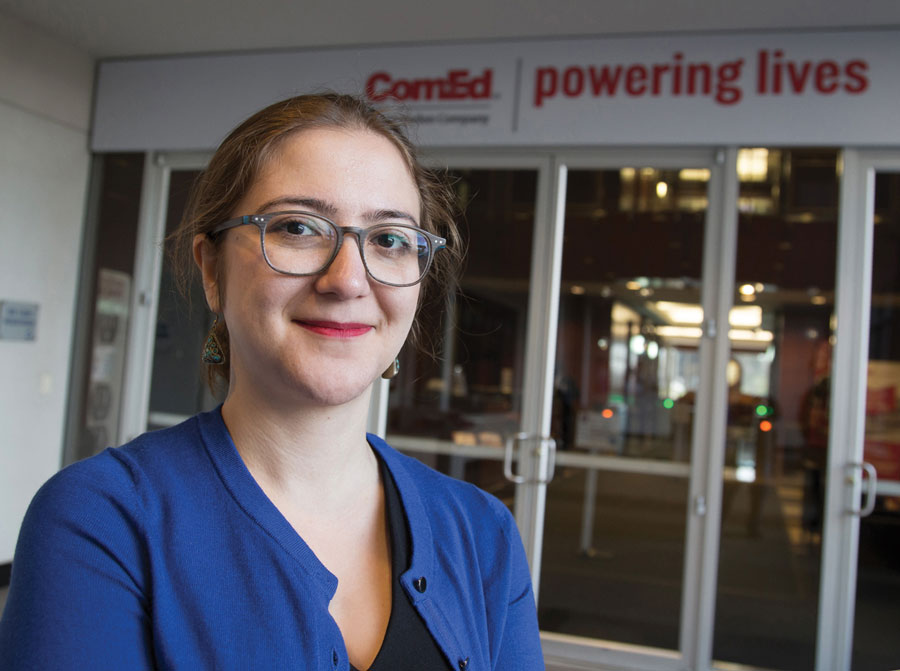We all know what electricity does, but what does it look like? As manager of smart grid and technology for ComEd, Shay Bahramirad (Ph.D. EE ’10) is working to build a new form of electricity delivery that allows users to track and control—effectively see—their own energy use.
“The technology that is being put into place through the smart grid and smart meters will, for the first time, give our customers a clear look into the way they are using their electricity [so they can] make informed decisions about how and when they use their energy,” says Bahramirad.
To make the otherwise invisible visible, the smart grid integrates cutting-edge information and communication technologies into the existing electric power system. Energy providers can conduct more broad-based, real-time monitoring and control of the system, employing such innovative tools as distribution automation devices, which make the grid self-healing by rerouting power around trouble spots and avoiding outages. Customers can use smart meters to observe their energy use and choose to operate appliances at times when electricity prices are lowest.
While lower energy prices might prove to be the bottom-line benefit for many customers, the biggest improvement over the existing electricity system will be what customers won’t see: how power outages are detected and reported.

Photo by: Michael Goss
“Smart meters have a function called a ‘last gasp,’ which tells us when a customer is out of power,” says Bahramirad. “Currently, customers need to call us and let us know when their power is out. The ‘last gasp’ functionality lets us respond more quickly to power outages and shorten their duration.”
The in-a-nutshell aim of the smart grid—improved reliability—parallels Bahramirad’s no-frills summary of her job.
“My work description is simple: keeping the lights on,” she says. Like the smart grid this involves multiple layers, which include leading ComEd’s microgrid deployment activities; coordinating ComEd’s smart grid data analytics; and establishing the Innovation Hub, which nurtures innovation within the company’s existing ranks. The latter is a key way that the energy giant looks to reshape itself by training current employees on smart grid issues in the context of their preexisting areas of work.
“We are in a critical juncture in which, from one side, new technologies are introduced and need to be efficiently integrated into the existing system, and from the other side, customers’ expectations are at their all-time high,” she says. She adds that ComEd’s new smart grid office will help the company’s employees embrace the new smart grid environment and be better prepared to address current and future challenges of this system.
For Bahramirad, education extends beyond the walls of her company. She teaches two courses at IIT on novel concepts of renewable energy resources in power systems, design and deployment issues, and the fundamentals of designing electrical systems in buildings. In addition to mentoring students, she is the chair of Women in Power, a committee of the IEEE Power & Energy Society that aims to drive change in the energy industry by fostering a more diverse leadership.
Three More Questions for Shay Bahramirad (Ph.D. EE ’10), Manager of Smart Grid and Technology for ComEd
When you meet a new person who asks you what you do for a living, how do you explain the concept of a smart grid?
The smart grid is the convergence of the twentieth-century power grid with twenty-first-century information and communication technologies. The electricity infrastructure was mainly built in 1960s and evolved over the years to become the electric power grid we currently use. The monitoring and control of this complex system, which is also identified as the largest machine ever built, has always been a challenge for system operators. Smart grid technology aims to integrate information and communication technologies, developed significantly in recent years, to the electric power system in order to enable real-time monitoring and control, and to further address all-time high expectations of consumers for a reliable supply of electricity. This evolvement further provides the required groundwork to integrate new technologies to the power system, such as renewable energy resources, energy storage systems, electric vehicles, and controllable electric loads. Advantages are significant and tangible for the average consumer by reduced outages, lowered energy costs, reduced emission, and better management in response to extreme weather events.
IIT has a prototype smart grid on campus. ComEd is a large company serving thousands of people. What are some of the biggest challenges in scaling up this technology?
Economic and regulatory issues can be identified as two major challenges. First of all, deployment of the distributed generation is costly. Although providing significant reliability benefits for individual customers and the system, the high capital cost of these resources acts as a barrier in their rapid deployment. ComEd is incentivizing the deployment of distributed energy resources in its territory and further purchases customers’ excess generation under the net-metering policy to help reduce investment payback time. The regulatory issues also need to be addressed to streamline ownership and economic dispatch of energy resources by ComEd.
What do you find most interesting, personally, about smart grid technology? What excites you most as someone working in this innovative area?
What I find the most interesting about smart grid technology is the impact it will have on people’s lives by enabling access to a reliable and sustainable supply of electricity. We are becoming more and more dependent on electricity; a strong and smart infrastructure is needed more than ever to address our current needs. We also keep an eye on the future by enabling integration of renewable energy resources that ensure sustainability of electricity supply for future generations and reduces environmental impacts. The smart grid had enabled us to measure, collect, and analyze data in smaller time resolutions, which accordingly resulted in finding a viable solution to the problem. Data provided by the smart grid could provide us with significant power making smarter and better choices about how we manage our system and offer electricity-related services to our consumers.